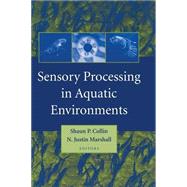
Note: Supplemental materials are not guaranteed with Rental or Used book purchases.
Purchase Benefits
What is included with this book?
| Foreword | p. v |
| Preface | p. vii |
| Contributors | p. xv |
| Introduction | p. xix |
| Color Plates | p. 202 |
| Navigation and Communication | |
| Introduction | p. 1 |
| Sound Detection Mechanisms and Capabilities of Teleost Fishes | p. 3 |
| Trails in Open Waters: Sensory Cues in Salmon Migration | p. 39 |
| Detection and Use of the Earth's Magnetic Field by Aquatic Vertebrates | p. 53 |
| Finding Food and Other Localized Sources | |
| Introduction | p. 75 |
| Physical Principles of Electric, Magnetic, and Near-Field Electric, Magnetic, and Near-Field Acoustic Orientation | p. 77 |
| Active Electrolocation and Its Neural Processing in Mormyrid Electric Fishes | p. 92 |
| Processing of Dipole and More Complex Hydrodynamic Stimuli Under Still- and Running-Water Conditions | p. 108 |
| Information Processing by the Lateral Line System | p. 122 |
| Retinal Sampling and the Visual Field in Fishes | p. 139 |
| The Coevolution of Signal and Sense | |
| Introduction | p. 171 |
| Underwater Sound Generation and Acoustic Reception in Fishes with Some Notes on Frogs | p. 173 |
| The Design of Color Signals and Color Vision in Fishes | p. 194 |
| Color Vision in Fishes and Its Neural Basis | p. 223 |
| Chemically Mediated Strategies to Counter Predation | p. 236 |
| Mechanisms of Ultraviolet Polarization Vision in Fishes | p. 252 |
| Aspects of the Sensory Ecology of Cephalopods | p. 266 |
| Recent Progress in Aquatic Vertebrate Olfaction | p. 283 |
| Visual Adaptations to Limited Light Environments | |
| Introduction | p. 301 |
| Eye Design and Vision in Deep-Sea Fishes | p. 303 |
| Spectral Sensitivity Tuning in the Deep-Sea | p. 323 |
| Visual Adaptations in Crustaceans: Chromatic, Developmental, and Temporal Aspects | p. 343 |
| Central Coordination and Evolution of Sensory Inputs | |
| Introduction | p. 373 |
| Sensory Systems and Brain Evolution Across the Bilateria: Commonalities and Constraints | p. 375 |
| Electroreception: Extracting Behaviorally Important Signals from Noise | p. 389 |
| In a Fish's Mind's Eye: The Visual Pallium of Teleosts | p. 404 |
| Paddlefish and Platypus: Parallel Evolution of Passive Electroreception in a Rostral Bill Organ | p. 420 |
| Index | p. 435 |
| Table of Contents provided by Syndetics. All Rights Reserved. |
The New copy of this book will include any supplemental materials advertised. Please check the title of the book to determine if it should include any access cards, study guides, lab manuals, CDs, etc.
The Used, Rental and eBook copies of this book are not guaranteed to include any supplemental materials. Typically, only the book itself is included. This is true even if the title states it includes any access cards, study guides, lab manuals, CDs, etc.